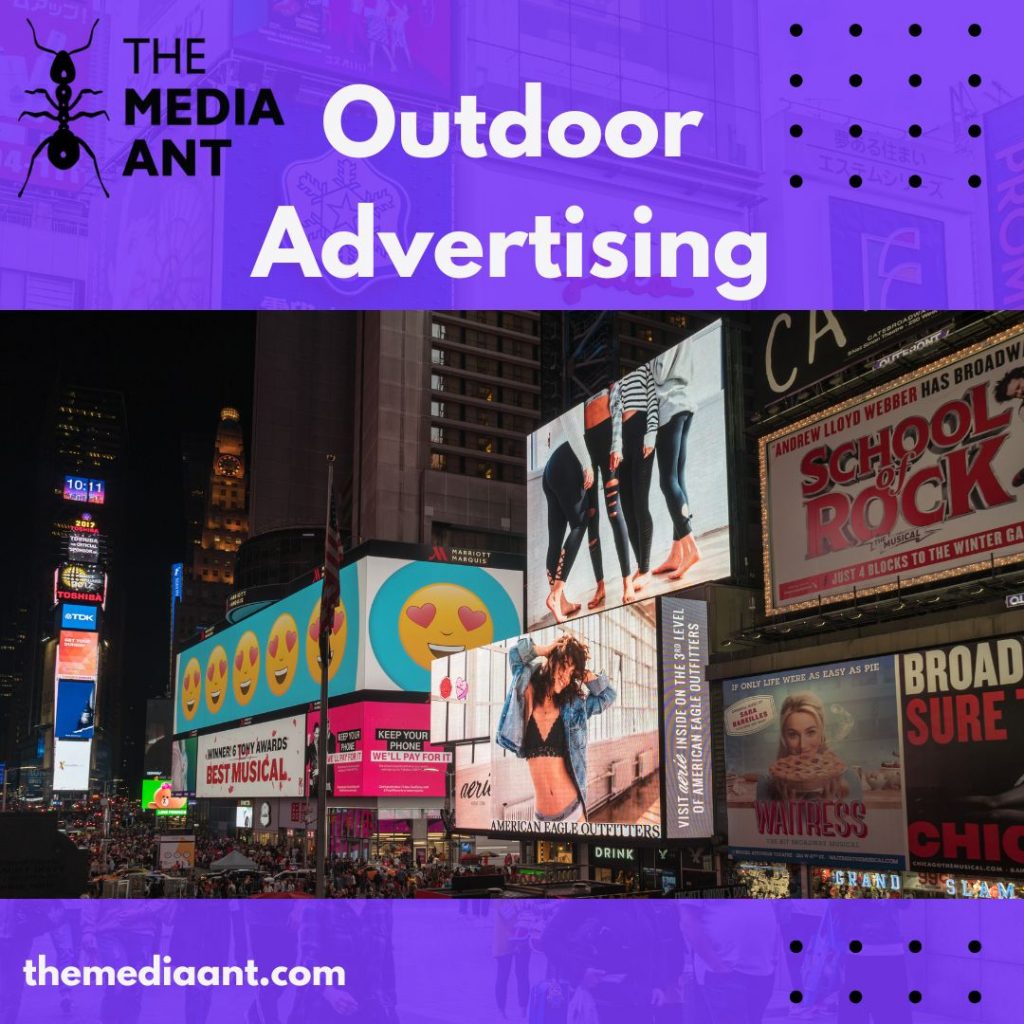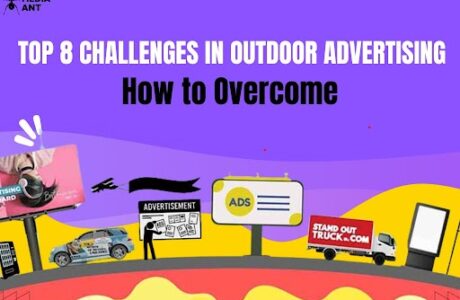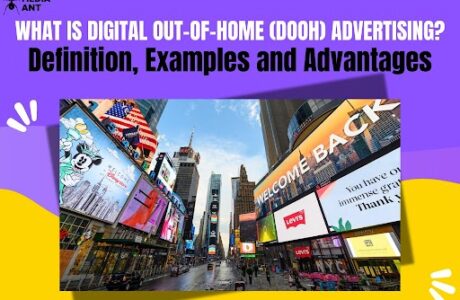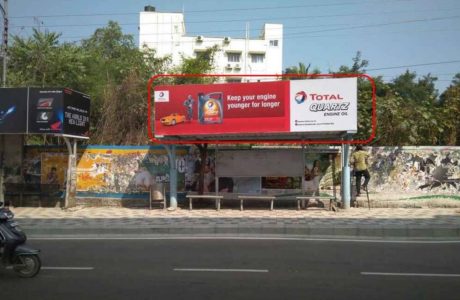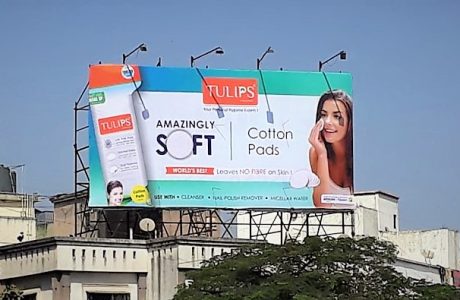What is Outdoor Advertising?
Outdoor advertising collectively refers to all media options that are displayed outdoors like billboards, posters, bus-shelter ads, transit ads, neon sign boards and so on and it is the most popular form of traditional advertising. In the industry, it is commonly referred to as OOH (out- of -home) advertising as it includes methods of advertising that are designed to reach consumers when they are out of their homes.
Outdoor advertising can be placed along highways, near stores or educational institutions, on mobile billboards, almost anywhere the law permits. While billboards are the most popular form of outdoor ads, digital out-of-home advertising is the fastest growing one. Although outdoor advertising is at times susceptible to damage by harsh weather and vandalism, generally it is a highly effective way to-
- Build brand awareness
- Boost visibility
- Drive sales especially for local businesses.
The success of outdoor advertising campaigns depends mainly on factors like location, duration, ad dimensions, and the visuals of the ad like how you make a logo, imagery, font and color though the location is considered by many to be the single most important factor. A good outdoor advertising campaign delivers the right message, at the right time and place, to the right audience. The advertising is highly targeted and relevant in terms of location, demographics, consumer behavior and part of the day.

What is Outdoor Media?
Outdoor media also refers to all the media options that are used to display ads outdoors. Outdoor media options include billboards, posters, kiosks, bus-shelters, transit advertising, street furniture advertising and other such options. Outdoor media are the most popular form of traditional advertising and can be found in all kinds of locations including highways, bus stands, subway stations, markets, residential areas, and so on.
Sometimes media options like fliers, pamphlets, and t-shirt advertising are also taken as outdoor media. When the goal is to build brand recognition and establish market presence, outdoor media is usually the go-to for most advertisers. Billboards are the most popular form of outdoor media while digital billboards are the fastest growing ones. Since they target customers while they are out of their homes, they are also called OOH (out-of-home) media in the industry.
Types Of Outdoor Advertising
Although hoardings, bus shelter advertising, auto advertising, etc are some of the most well-known and predominant outdoor advertising examples, the media options are not limited to just that. There are many different types of Outdoor advertising and they can be broadly classified into four main categories. They are –
1. Hoardings
Hoardings, also known as billboards, are generally located in high traffic areas such as along highways or near shopping malls to attract the attention of the highest number of drivers and pedestrians.
This type of outdoor advertising is really effective at creating and boosting brand awareness as the ad is always visible 24×7.
2. Transit advertising
Transit advertising collectively refers to all kinds of advertising placed inside or on modes of public transportation or in public transportation precincts like auto branding, cab branding, metro advertising, bus shelter, bus branding, airports, petrol pumps, train branding and train stations. This type of outdoor advertising is one of the least expensive ways to advertise and is a favorite among local advertisers as it allows them to reach a very select segment of the population.
The transit ads displayed inside the vehicle also carry the unique advantage of a long exposure to the ad as people are exposed to the ad for the entire length of the ride.
3. Street furniture advertising
Street furniture includes options like, news racks, mall kiosks, ATM kiosks, park benches and telephone booths. This type of outdoor advertising is known as street-level urban media, street furniture is placed at eye level for foot traffic and can be really attention grabbing for pedestrians as well as commuters. People can really absorb and engage with the message of the ad as they wait for their bus or train. They are also fairly inexpensive and allow the advertisers a good scope to get creative with their ads.
4. Non Traditional advertising
Besides above-mentioned outdoor advertising examples, there are also a lot of ever-growing alternate/non-traditional outdoor media options such as walking billboards, pole kiosks, hot-air balloons, sailboats and malls advertising (kiosks, standees, cutouts, elevator wraps, cricket stadium, food court advertising. LED screens).
Types of Advertising Boards
There are about as many types of advertising boards in the market as there are creative heads, but following are the most popular ones:
1. Bulletins
Bulletins are the classic billboards that can be seen on highways or heavy traffic streets. Bulletin sizes vary depending on location, but the typical bulletin billboard measures 14 feet in height and 48 feet in width. They are the biggest size billboards.
2. Posters
Posters are usually about half the width of classic billboards. They are mostly used for the advertisement of a local product and target the local market.
3. Vinyl billboards
Vinyl billboards have a much brighter appearance than ordinary billboards and are usually spread with UV resistant paint. They are among the most durable types of advertising boards and can survive some of the harshest weather conditions. They have an average lifespan of 3-5 years.
4. Painted billboards
Painted billboards are among the types of advertising boards that you rarely see anymore as most clients now prefer graphically produced billboards.
5. Digital billboards
Digital billboards are the most expensive type of advertising boards and are generally used at central business points. These billboards display digital images that are changed by a computer every few seconds. These are the most advanced types of advertising boards.
6. Mobile billboards
Mobile billboards are placed on top of vehicles that carry the ad around everywhere they go.
Outdoor Advertising Examples
1. POLE KIOSK ADVERTISING
2. AUTO ADVERTISING
3. DIGITAL BILLBOARD
4. METRO PILLAR ADVERTISING
5. METRO STATION ADVERTISING
6. BUS SHELTER ADVERTISING
Case study on the launch campaign of Cadbury’s new chocolate ‘Fuse’
The launch campaign of Cadbury’s new chocolate ‘Fuse’ was done in top 26 cities including Mumbai, Delhi and others. The core objective of the campaign was to promote Fuse as a new way of snacking with the tagline “Feast Up”.
The main media used for this campaign included “Metro Train Wrap” in Mumbai mainly in the Versova-Andheri-Ghatkopar metro route. The campaign was aimed at reaching out to the youth aged between 15-25 years across SEC A & B.
According to the data shared by Mumbai Metro, this route has footfalls of more than 30 lakh passengers in a month. Being a high traffic route, it not only garnered the travelers attention, but also of the road travelers.
Another Non Traditional medium used included Bus Wraps in these major cities like Mumbai, Bangalore etc.
Focusing on both effectiveness and reach, media like billboards, unipoles, gantries, mall facades, metro civil structures, pillars, bus shelters and other signages were also used.
To create a strong top of mind recall, only a single ad creative has been used across all the cities. This is prominently in the brand color purple, showcasing the key ingredients of the product – chocolate and peanuts with the line ‘Chocolaty Feast’.
Want outdoor advertising for your brand but haven’t got enough budget for hoarding?
Don’t worry, there are endless other interesting and cheaper options as well:
- Bus Shelter Advertising: Bus shelters are places where a large number of people gather while waiting for buses.
- Road Median Advertising: Road Medians are small-sized boards placed on the dividers between the roads. These are usually cheaper and can be used in large numbers to create repeated impact.
- Pole Kiosk Advertising: Pole kiosks are mounted on the poles between and beside the roads.
Metro Pillar Advertising: With the Metro railway covering many parts of the tier 1 cities, metro pillar advertising has emerged as a popular option for outdoor advertising.
Why should brands go for Outdoor Advertising?
In today’s digitally driven times, an advertiser might wonder if going for outdoor advertising is the right step for their brand. While there is no denying that outdoor advertising provides tremendous brand reach and boosts brand recall, the benefits don’t end just there.
Here are a few other advantages of outdoor advertising:
- Outdoor Advertising is effective for mass targeting. Any brand looking to target a large group of people should consider this advertising over anything else.
- Outdoor Advertising (especially hoarding advertising) is often associated with a premium brand image.
- The size of hoardings and the fact that outdoor advertising can be repetitive, creates an impact in the mind of potential consumers which in turn helps in brand recall.
- This type of advertising is always good for brands looking to do hyperlocal targeting.
Who should opt for Outdoor Advertising?
Should outdoor advertising be the top choice for an advertiser looking to run a marketing campaign? There are many factors that should be considered before you jump to the conclusion that outdoor advertising is the right step for your brand. Factors like the brand’s target audience, budget and preferred geographical area have a big role to play in this decision making process.
Talking from a general perspective, here are the brands that should consider outdoor advertising:
- Local brands- Local brands looking to target an audience in some limited specific geographic area, with a limited budget can leverage the cheaper options of outdoor advertising like bus shelter advertising, bench advertising, auto advertising etc for their promotion.
- National brands– National brands for which the target audience falls in a broad category like that of FMCG, and a high advertising budget, can leverage the power of outdoor advertising to create an impactful ad campaign using billboards or hoardings as their preferred outdoor ad medium.
How much does Outdoor Advertising Cost?
Outdoor advertising costs are as wide in their range as the number of outdoor advertising options itself.
The cost is dependent on a lot of different factors- from the size of the ads to the type of media selected (whether it’s billboard or metro pillar advertising).
Therefore, if you’re planning an ad campaign and want to get estimate of your outdoor advertising cost consider the following parameters before you decide on a budget-
- Type- Outdoor advertising cost depends greatly on the type of media options used. What kind of outdoor advertising are you looking for? Is it metro, bus shelter, auto or billboard? Everything will have a different cost. Places with high footfall will also change the rates to a high degree as billboards placed in popular locations will be costlier than the ones placed in comparatively less popular locations.
- Size- The size of the ad will also play a major role in determining the cost of the media option. Small size billboards will cost more than bigger ones..
- Location- Billboards and banners that are placed in places of high visibility will be costlier than those in normal places. A distance of as short as 1 km can impact the outdoor advertising cost.
- Direction- Considering the type of media to be billboards in this case, the ones placed towards the direction of the traffic will cost more than the ones facing opposite to the direction of the traffic.
- Lit/Non Lit- Outdoor advertising cost will also depend on the fact that whether it’s a lit or a non- lit billboard. Lit billboards, as the name suggests, are ones that have light on them and hence they cost more than normal/non-lit billboards.
- City- Location is of prime importance when it comes to outdoor advertising. The outdoor advertising cost varies from one location to another in the same city itself. Therefore it definitely will vary from one city to another. Ads in Tier1 (metro) cities will cost more than those placed in tier 2 or 3 cities.
Challenges in Outdoor Advertising
Despite the many benefits that it offers, outdoor advertising comes with its own set of challenges. While these challenges might appear more from an environmental and less from a business perspective, they are challenges nevertheless.
Some of them are as follows:
- Usage of non-sustainable printing material led to commercial hoardings being banned in Bangalore. The ban imposed (though lightly implemented) by the govt of India on single-use plastic have also paved the way for the emergence of DOOH in India as most of the traditional billboards use plastic-based vinyl.
- The normal hoardings tend to ruin the aesthetics of the city.
1. The Rise of Digital OOH (or DOOH) in India
Digital OOH, also known as DOOH, is the fastest growing branch of outdoor advertising. It includes various types of digital media like digital billboards, digital kiosks, small digital sign boards, elevator screens and TV screens, though in India we have limited digital OOH options. Digital OOH in India are mostly seen in airports, subway stations and shopping malls. Here, it is limited to a small number of locations in a few metro cities like Mumbai and Delhi. However, with new luxury shopping malls springing up all over the country, the prospects of the growth of DOOH in India are only getting better day by day.
At present, DOOH advertising is gaining immense popularity in India on account of the growing internet penetration and rapid digitization. The ban imposed (though lightly implemented) by the govt of India on single-use plastic should also pave the way for the emergence of DOOH in India as most of the traditional billboards use plastic-based vinyl. Although, at present the DOOH in India can only be found in places like Malls, Multiplexes, Corporate Parks, Restaurants and IT Hubs, the urban India landscape is expected to soon be dotted with DOOH media in a couple of years as the digital-India initiative gains ground.
The growth of DOOH in India, however, might be impeded by our heavy reliance on China for supplies of materials that go into setting up digital billboards unless there is a considerable improvement in the relationship between the two countries.
2. OOH full form in Advertising
OOH full form in advertising is nothing but an abbreviated term for ‘’out of home’’ in advertising which simply means outdoor advertising. It is called out-of-home because people see this kind of ads when they are outside as opposed to, say, newspaper ads which they see when they are inside their homes or workplaces. OOH full form in advertising or out of home advertising is the umbrella term for all kinds of outdoor advertising from billboards to transit ads.
It’s mostly a matter of industry jargon, and let’s face it, OOH full form in advertising, i.e, ‘out of home advertising’ sounds a lot heavier than simply OOH advertising.
Difference Between Hoarding and Billboard
While deciding on the ideal outdoors advertising option for your campaign, you are very likely to find yourself wondering what is the difference between a hoarding and billboard, right? There is no stark difference between hoarding and billboard and the two terms are often used interchangeably in the industry as both media options are almost identical in their promotional functioning as well as appearance. Of course, since the ever-increasing creative innovations in advertisements don’t help either, it makes it even harder to distinguish between the two at first glance.
A simple way to tell which is which, though, would be to remember that a billboard is just the better-looking cousin of a hoarding. If your personal vocabulary happens to be industrially inclined, just remember that a billboard is nothing but a premium hoarding. Although today the difference between hoardings and billboards has blurred, traditionally, the word hoarding used to be reserved for the boarded fences that are usually erected around a construction site and used to advertise the firms working there. In 2022, however, the kind of hoardings most people are familiar with is probably those rectangular ads displayed along the side-lines in football/ cricket fields.
The difference between billboards and hoardings is most pronounced in the variety of options available in each medium. With Bulletins (classic billboards), digital billboards, mobile billboards, Vinyl billboards, and painted billboards, the billboard is the medium with more options. Billboards are also more diverse in terms of their size and the number of locations you can find them in.
Difference Between Transit Advertising and Wraps
Transit advertising includes all advertisements that are displayed inside different modes of public transit from auto rickshaws to airplanes, along with the ads pasted on the bodies of these vehicles, and the ads put up at public transit precincts like subway stations and bus stands. The transit ads displayed inside the vehicle carry the unique advantage of a long exposure to the ad as people are exposed to the ad for the entire length of the ride. Interior transit advertising also provides the benefit of repeated exposure to the ad as people tend to take the same bus or train to work every day. Transit advertising is one of the most inexpensive forms of outdoor advertising and is preferred mostly by local and small-scale businesses.
Vehicle wraps are the ads pasted on the exterior of the bodies of buses, cabs, and auto rickshaws.They function as mobile billboards, taking your ad wherever the vehicle goes. With wraps, ads can be placed on both sides of the vehicle, at the back of the vehicle or on the roof. Vehicle wraps are the most popular form of transit advertising as it targets both commuters and passers by. Auto rickshaw hood wraps are really popular in India while bus wraps are more popular in the UK and the US.
How to Select the Right Outdoor Spot/Site for your Brand?
Location location everywhere, which location to finalize on?
If your mind has ever been befuddled by the fact that how can an advertiser pick one OOH location from a sea of OOH locations, then this section is the one for you. Once you finish reading this, you would have the answers to questions like:
- What things need to be considered before you settle on ‘that one location’?
- How do I pick one that would give the best ROI?
- What types of OOH sites are there?
What is ‘Site Recce’ ?
A common practice and term in outdoor advertising is therefore, ‘Site Recce’.
‘Recce’- an outdoor lingo, translates to ‘location scouting’. This process of location scouting involves taking the client out on a ride around the city in order to show or make them choose the right OOH media assets (which can be billboards, bus shelter, etc.). The objective is to familiarize the client with that particular location and get their ‘go-ahead’ signal or approval to take things forward.
Types of Outdoor Sites
So, as an advertiser, do you know and understand the different types of sites and their unique significance? Knowing this would not only help you understand why you should pick a particular site but also help you avoid the ones that don’t give you the required ROI on your investment.
Read below to find out:
1. Sites with long visibility
These are the most desirable sites but they come with a catch. Although these sites enjoy the advantage of being in a long viewing distance (which means the viewer would be able to see it for a long time before it passes by them), if the font used in the ads is not legible, the viewer will lose interest instantly. Therefore, content size (legibility) needs to be in sync with viewing distance.
2. Sites on the curve or turn
These sites are the best ones and grab the most attention. In this location, the mental overload of the viewer is higher as at this time, the eyes and mind coordinate to cope with the turn with a very high alertness. Therefore a higher number of fixations in between saccades occurs. This same logic applies to sites which are present at the top of a bridge or a flyover.
3. Sites that are on or away from the pavements
These sites are also called deflected sites and do not enjoy the sweet breeze of popularity as much as the other sites do. Cars these days have a massive headrest which leads to the viewer getting a small visibility through the aperture in front. Such passengers’ interest lies through the side windows. And that’s where the displays are placed on sidewalks and even further away from work.
4. Sites around run down areas
The sites placed/found near or around areas like the front of slums or unclean environments will be well received by the viewer since it behaves as a welcome distraction for the viewer from the unclean surroundings around them. It creates a positive deflection in the mind of the viewer and they pay more attention to the ad rather than the repulsive surroundings.
5. Sites around clean spots
These sites work just the opposite of the above mentioned ones.
Why? Because people will pay more attention to the beautiful surroundings rather than the ad being placed there. It will also create a negative bias in the mind of the viewer by making them think that the ad is ruining the cityscape. We would like to express our heartfelt gratitude to Abhijit Sengupta, an Out Of Home Specialist and outdoor advertising veteran, whose LinkedIn post on the importance of site selection in OOH or ‘Recce’ inspired us to include this crucial topic in our article.
In his post, he outlined topics like illustrations on the importance of Recce in OOH media, the factors that affect the selection process of the right OOH site and the different types of sites. Mr Sengupta, in his post, also talked in detail about factors like ‘route familiarity’ and how it leads to greater distraction while driving, because familiarity increases the effect of ‘mind wandering’, thereby making the viewer lose focus.He also goes on to analyze human behavior as they move on roads and how it is directly dependent on the individual’s cognitive ability and driving skills.
Why Does Choosing the Right OOH Site Matter?
Anyone who’s ever done outdoor advertising would agree that the charm of outdoor advertising begins and ends at finding that one perfect location to advertise on. That’s the reason why, in OOH advertising, the process of selecting the right location holds prime importance and advertisers pay good money solely for this one simple reason. Since all the competition revolves around which brand grabs the best site with maximum footfall; advertisers, vendors and ad agencies employ the process of location scouting.
This simple yet crucial process involves visiting the location in person in order to make sure that the site is worth paying money for. And needless to say, everyone wants that OOH site which is ‘the best’ or most expensive one. So what factor decides that these sites are the best? Generally ‘the best’ sites are the ones in any prime location. A hoarding, for example, in any prime location would enjoy greater visibility than a hoarding in a not so popular site due to high footfall in that particular prime location.
What is the Cheapest Mode of Advertisement?
Outdoor ads have always been one of the best ways for brands to get strong visibility. Even today, outdoor ads are giving high competition to any other form of advertising whether it’s digital or tv .The larger-than-life emotions attached to outdoor ads have helped them stay on top of the advertising business since its inception. Yes, it does require a certain threshold of budget, but if your brand has it, then these outdoor ads know how to make a brand awareness campaign a successful one.
The rates of outdoor advertising vary greatly from location to location and vendor to vendor, and there is no universal cheapest mode of out of house media, though certain media options are always more expensive than others. For instance, billboards are always costlier than pole kiosks. That said, different types of street furniture advertising like transit shelters, newsstands, kiosks, convenience store panels, store signage, etc are generally quite inexpensive as compared to most other options. Besides street furniture, car magnets, stickers, posters, flyers and coupons are usually the cheapest modes of outdoor advertising and are frequently employed by small and even medium-sized businesses.
Car magnets are a great alternative for vehicle wraps if you want mobile advertising for your business and don’t have the budget for vehicle wraps. If the return on investment is your priority, then having someone hand out promotional pamphlets and flyers is one of the most cost-effective methods you can employ. If you are willing to be experimental with your ad campaign, you can also use bicycle advertising to promote your business at a very low cost. All you have to do is have your poster-boards mounted behind the seat of a bicycle and you get the cheapest mobile billboards in the market.
Times Square Advertising: What Do You See?
When it comes to New York City, one of the most iconic places to visit in the bustling metropolitan maze is Times Square. There’s a reason why advertisers all over the world are all willing to invest in Times Square and gain one of those coveted spots on the iconic billboards—they’ll have a reach of up to 40+ million people every single year. And, studies indicate that can bring in a company millions and millions of dollars simply by having times square billboards.
Times Square advertising is an iconic and key part of New York City. Advertisers are willing to invest millions in these billboard spots because they know that the reach can be up to 40+ million people every year. Well, if you are thinking of giving your brand extensive reach then Times Square New York advertising can give your branding and sales extra bonanza.
Benefits of Advertising in Times Square New York Advertising
Companies and brands that are dedicating their budget to Times Square advertising are expected to get approximately 200,000 unique daily impressions. If every passerby sees their ad at least once, your brand can get maximum reach and visibility, all thanks to the popularity of the space. You’d be interested to know that the most expensive billboard in Times Square is about 125,000 sq ft which is at 1535 Broadway, that is impressively eight storeys high. Here’s a fun fact, the first time the Times Square was rented was by Google in 2014 that too for a mind-blowing price and for four weeks display time. This makes the place one of the most iconic advertising spots which every brand wants to tap in.
Times Square is filled with ads because it has become a growing tourist attraction and has high traffic in the area at almost all times of the day. In fact, before the pandemic the average pedestrians in Times Square was an average of 360,000 per day. Now combine the prominent media coverage of the spot with festive days like Christmas and New Year’s. The place is visited by a wide audience per year, and its incredible reach opportunities for brands make it one of the most valuable public ad spaces in the world.
In fact, one of the first ever electronic billboards on Times Square dates back to 1997 which was sold at a high price, and it incentivized more and more brands and advertisers to spend on Times Square New York advertising. Brands such as Samsung, Apple, Google and Budweiser are some of the examples of organizations that have actively advertised their products on this iconic location.
Times Square Advertising Cost
Looking for the best rates for Times Square advertising? The Media Ant can help you get the best and cost-effective rates for advertising in Times Square. Your ad campaigns can be planned and carried out by the Indian advertising firm The Media Ant on Times Square New York and in the media type of your choice. Advertise with us and find the best pricing and transparency regarding your advertising campaign. For additional information, you can contact us or go to The Media Ant website.

Here’s why The Media Ant is different
An advertiser looking to find an outdoor ad agency might never run short of options because of the high availability of advertising agencies in almost every city of India. The real struggle comes when one has to pick the best among thousands of available options.
Why is the Media Ant different from other outdoor ad agencies?
With The Media Ant your brand is put in the best hands as we strive everyday to provide top notch outdoor advertising service to our clients. We have a dedicated team to look into your every need and provide you with the best outdoor advertising rates. Whether it’s campaign planning or monitoring, our team will take care of you at every step of the way so that you don’t have to worry about anything. We make your outdoor advertising journey seamless from inception to the end.
With more than 10 media options to advertise on and thousands of categories to choose from, you will never run out of options with The Media Ant. Not only this, we make sure you get the best updates rates no matter which vertical you want to advertise on.
Connect with us at Help@themediaant.com and begin your advertising journey the right way!

